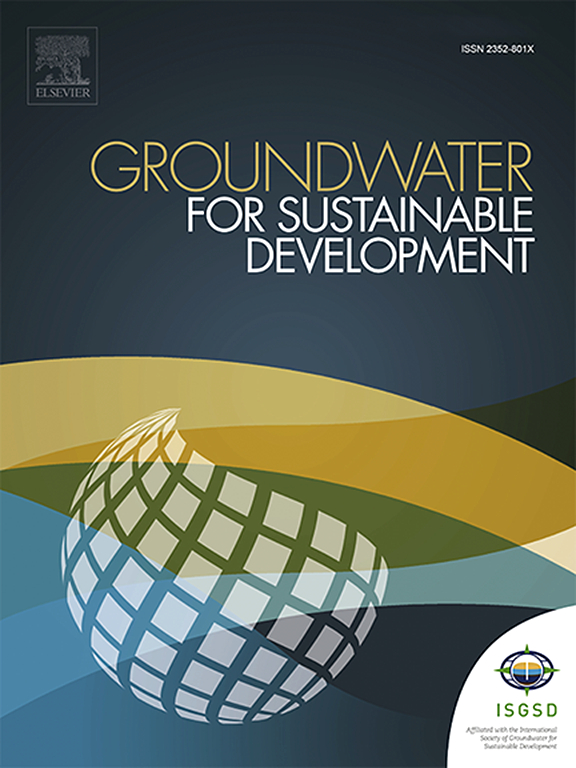Modelling for drought evolution and some hydrological implications over a semi-arid terrain using earth observation techniques
IF 4.9
Q2 ENGINEERING, ENVIRONMENTAL
引用次数: 0
Abstract
Droughts are climate change phenomena that affect watersheds, causing reduced stream flows and poor groundwater recharge. Their evolution seeks a greater understanding of meteorological conditions that perpetually propagate into the hydrological system and gradually results into reduced stream flows. The present study investigated the Shetrunji river basin in Saurashtra region of western India and detected 14 hydrological droughts between 1984 and 2021. The Soil and Water Assessment Tool (SWAT)-based simulations helped to construct past drought cycles using Standardized Runoff Index (SRI) and Standardized Precipitation Index (SPI). Multi-site calibration and validation processes resulted in a higher accuracy of ranking among influential factors with baseflow and curve number as the top two sensitive parameters. Evaluation metrics for acceptable scores were set for R2 (>0.50), NSE (≥0.60) and PBIAS (±25 %) for streamflow. The mean drought intensity ranged from 1.31 to 0.92, with peak severity values of −3.03 for meteorological and −4.14 for hydrological droughts respectively. June and July are the most common months for long-term droughts of hydro-met origin. Hydrological droughts followed meteorological droughts, had slower progression, longer duration, and more severity. The region has experienced distributive phases of change over 38 years, highlighting the region's deviated hydro-meteorological patterns. Evaluation and understanding of the nature of historic droughts of this region shall benefit the policy-makers at an upscaled level to provide thus, adaptive solutions at the local level.

利用地球观测技术模拟干旱演变及其对半干旱地形的水文影响
干旱是影响流域的气候变化现象,导致河流流量减少和地下水补给不足。它们的进化是为了更好地理解不断传播到水文系统并逐渐导致河流流量减少的气象条件。本研究调查了印度西部Saurashtra地区的Shetrunji河流域,并在1984年至2021年间发现了14次水文干旱。基于SWAT的模拟利用标准化径流指数(SRI)和标准化降水指数(SPI)构建了过去的干旱周期。多站点校准和验证过程使基流量和曲线数为前两个敏感参数的影响因子排序精度更高。可接受评分的评价指标为流流量的R2 (>0.50)、NSE(≥0.60)和PBIAS(±25%)。平均干旱强度为1.31 ~ 0.92,其中气象干旱峰值为- 3.03,水文干旱峰值为- 4.14。6月和7月是水文气象长期干旱最常见的月份。水文干旱在气象干旱之后,发展速度较慢,持续时间较长,严重程度较高。38年来,该地区经历了分布阶段的变化,突出了该地区水文气象模式的偏差。对该地区历史干旱性质的评估和理解将有利于决策者在更大的层面上提供相应的适应性解决方案。
本文章由计算机程序翻译,如有差异,请以英文原文为准。
求助全文
约1分钟内获得全文
求助全文
来源期刊

Groundwater for Sustainable Development
Social Sciences-Geography, Planning and Development
CiteScore
11.50
自引率
10.20%
发文量
152
期刊介绍:
Groundwater for Sustainable Development is directed to different stakeholders and professionals, including government and non-governmental organizations, international funding agencies, universities, public water institutions, public health and other public/private sector professionals, and other relevant institutions. It is aimed at professionals, academics and students in the fields of disciplines such as: groundwater and its connection to surface hydrology and environment, soil sciences, engineering, ecology, microbiology, atmospheric sciences, analytical chemistry, hydro-engineering, water technology, environmental ethics, economics, public health, policy, as well as social sciences, legal disciplines, or any other area connected with water issues. The objectives of this journal are to facilitate: • The improvement of effective and sustainable management of water resources across the globe. • The improvement of human access to groundwater resources in adequate quantity and good quality. • The meeting of the increasing demand for drinking and irrigation water needed for food security to contribute to a social and economically sound human development. • The creation of a global inter- and multidisciplinary platform and forum to improve our understanding of groundwater resources and to advocate their effective and sustainable management and protection against contamination. • Interdisciplinary information exchange and to stimulate scientific research in the fields of groundwater related sciences and social and health sciences required to achieve the United Nations Millennium Development Goals for sustainable development.
 求助内容:
求助内容: 应助结果提醒方式:
应助结果提醒方式:


